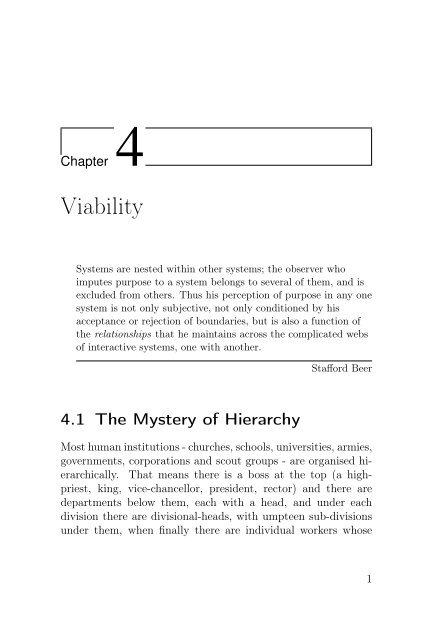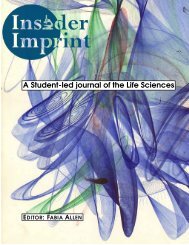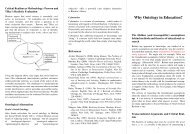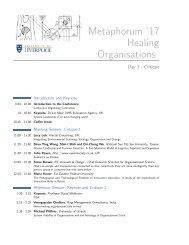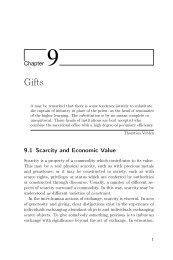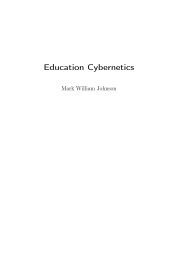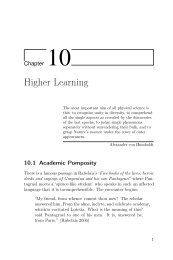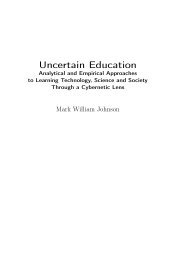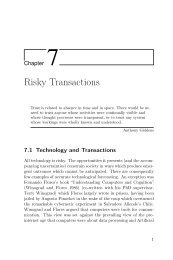education-cybernetics (5)
You also want an ePaper? Increase the reach of your titles
YUMPU automatically turns print PDFs into web optimized ePapers that Google loves.
Chapter 4<br />
Viability<br />
Systems are nested within other systems; the observer who<br />
imputes purpose to a system belongs to several of them, and is<br />
excluded from others. Thus his perception of purpose in any one<br />
system is not only subjective, not only conditioned by his<br />
acceptance or rejection of boundaries, but is also a function of<br />
the relationships that he maintains across the complicated webs<br />
of interactive systems, one with another.<br />
Stafford Beer<br />
4.1 The Mystery of Hierarchy<br />
Most human institutions - churches, schools, universities, armies,<br />
governments, corporations and scout groups - are organised hierarchically.<br />
That means there is a boss at the top (a highpriest,<br />
king, vice-chancellor, president, rector) and there are<br />
departments below them, each with a head, and under each<br />
division there are divisional-heads, with umpteen sub-divisions<br />
under them, when finally there are individual workers whose<br />
1
4 Viability<br />
function is to ensure that their divisional head can’t be blamed<br />
for anything. The hierarchy is a mechanism for apportioning<br />
blame.<br />
Universities use the same structure for the dual purpose of<br />
apportioning blame and structuring knowledge. The fact that<br />
these two functions are incommensurable is impossible to challenge<br />
within the university’s structures. The head of an academic<br />
department is in trouble if their students complain, or<br />
(worse) they don’t sign-up and this blame is apportioned irrespective<br />
of the merits of the particular branch of knowledge they<br />
represent. In the modern university, knowledge must be popular<br />
if it is to survive in the University hierarchy.<br />
In a hierarchy, each higher layer must coordinate the activities<br />
of each lower layer. This means that each divisional head must<br />
grasp the complexity of all that is happening in the layers below<br />
them, which might threaten them. Because the complexity of<br />
the body of staff for whom the manager is responsible is greater<br />
than the manager’s complexity, the manager must attenuate the<br />
complexity of the behaviour of the lower layers by Ashby’s Law.<br />
In modern organisations, the attenuation process is driven by<br />
information: data on everything from class attendance, student<br />
surveys, pass rates and student fee income. Impressive though<br />
this range of data is, and hypnotic is the capacity of modern data<br />
analytic software, the simple fact remains that such information<br />
is always constraint - it is always a tool of attenuation. This<br />
should lead us to worry about what gets left out - for it is usually<br />
what gets left out which suddenly reveals itself as a menacing<br />
force from nowhere and shocks hierarchies into existential panic.<br />
Such is the story of most of our recent institutional crises from<br />
the financial collapse of banks and corporations, child abuse in<br />
the church, illegal behaviour of journalists, Jimmy Savile, health<br />
scandals and MP expenses.<br />
Hierarchies are uncommon in nature. The brain is not the<br />
2
4.2 Heterarchy<br />
boss of the body. The body comprises multiple components<br />
which work together coordinated by signals passed through the<br />
central nervous system. Neither is the queen bee the boss of the<br />
hive, or the termite colony led by a “head termite”. In nature,<br />
in place of hierarchy, we see circularity. This is because natural<br />
structures seek viability and adaptability in response to a<br />
changing environment. Circular organisational structures help<br />
achieve this through continual organic adaptation.<br />
Human hierarchy is an anomaly in nature. Speculation as<br />
to why it exists leads to explanations invoking “human nature”,<br />
but the description of what hierarchy does in attenuating provides<br />
a clue as to the deeper reason why it exists. Unlike the<br />
human body, society’s nervous system is wired to attenuate: hierarchy<br />
appears amidst communicative failures. The promise of<br />
technology is that this incapacity might be overcome.<br />
4.2 Heterarchy<br />
The internet was designed non-hierarchically: it was a heterarchy,<br />
providing many possible routes for messages to be communicated<br />
across the network. This architecture, designed to<br />
withstand a nuclear attack, was itself inspired by the architecture<br />
of the brain, providing what Warren McCulloch called a<br />
“redundancy of potential command”.<br />
In a heterarchy, no single node has power over any other node<br />
in a structure. However, this does not mean that collections<br />
of nodes may not organise themselves to perform specific and<br />
distinct functions. The human body is a heterarchy, but the<br />
cells of the body organise themselves in specific functional units<br />
- whether in the brain, the heart, the liver and so on. As our<br />
understanding of the plasticity of stem cells is beginning to tell<br />
us, at the core of biological systems is the adaptability of the<br />
cell which continually adapts to complex environments.<br />
3
4 Viability<br />
The word Hetararchy was first introduced by Warren McCulloch<br />
through his study of the brain, and his attempt to establish<br />
similar structures in electronic components - work that laid the<br />
foundations for neural networks and machine learning. In Mc-<br />
Culloch’s neural networks, no node was more powerful than any<br />
other node. The interconnections between the nodes meant that<br />
each node could perform a simple function which could collectively<br />
articulate a logic. Today we use this logic of neural networks<br />
for image recognition, machine translation and automatic<br />
essay marking (more on that later!)<br />
It is in understanding the connection between interconnection,<br />
heterarchy and power that mystery of hierarchy can be understood,<br />
and the potential role of technology in addressing it can<br />
be explored.<br />
4.3 The Organisation of <strong>education</strong><br />
To study technology in <strong>education</strong> is to consider the ways communication<br />
occurs in <strong>education</strong>al institutions. Given the connection<br />
between lines of communication and organisational structure,<br />
this means that the object of scrutiny in <strong>education</strong>al technology<br />
is not software, hardware or pedagogy - it is the institution of<br />
<strong>education</strong> as an organism.<br />
Education is hierarchically organised, and its organisation is<br />
facilitated through the use of tools. Timetables, teachers, curricula,<br />
buildings, assignments, exams, lunchbreaks, textbooks,<br />
pens and whiteboards are all manifestations of <strong>education</strong>al organisation.<br />
So too are the political processes by which a society<br />
agrees how it is to be paid for. These are all things which we can<br />
point at when we talk of ‘<strong>education</strong>’. Each entity exists by virtue<br />
of custom and practice which has emerged over history. Each is<br />
subject to declarations made by governments, community leaders<br />
or institution heads at some point in time: x is a classroom,<br />
4
4.4 Technological Attenuation and “Form A2042”<br />
y is a textbook, z is a Learning Management System, and so<br />
on. Different declarations are possible. The <strong>education</strong> system,<br />
as comprised by declarations of this sort, of this sort could be<br />
radically different from what we have; all that is required are<br />
a different set of declarations. Yet we struggle to imagine an<br />
alternative world - even when equipped with new tools which<br />
could conceivably bring about better alternatives.<br />
In producing new options for acting, computer technology provides<br />
the means for overcoming existing constraints. Ironically,<br />
in doing so it increases uncertainty within institutions. Institutions<br />
are often uncomfortable with increasing uncertainty, and so<br />
their natural response is to use the technology to reinforce their<br />
existing structures rather than using the technology to overcome<br />
them. Computer technology can also reduce the multiplicity of<br />
description: from the richness of the multiple descriptions of the<br />
face-to-face relations in the Post Office, technology produces the<br />
pale ‘monovalent’ description of the online ‘form’ through which<br />
to apply for a new passport.<br />
4.4 Technological Attenuation and<br />
“Form A2042”<br />
In the technocratic institutions of today, commands like “Fill<br />
in Form A2042 ” are part of professional life. Today we would<br />
expect to find Form A2024 online. It is likely to have dropdown<br />
boxes with options which we may struggle to find the<br />
appropriate option to express what we want. In the knowledge<br />
of the institutional importance of such forms, we may well steer<br />
the conversations and actions of students and colleagues in such<br />
a way that “Form A2042 ” is easier to fill in. The complexity of<br />
such forms has evolved into methods of assessment for learners<br />
(multiple choice quizzes) or the collection of ‘competency’ data<br />
5
4 Viability<br />
in health or <strong>education</strong> as we saw in Chapter 1.<br />
The form was developed in the dawn of the modern age during<br />
the first world war. Form A2042 was the name given to the<br />
‘Field Service Post Card’, upon which soldiers could send brief<br />
messages home by crossing-out the options which did not apply.<br />
Paul Fussell claims it was<br />
‘the progenitor of of all modern forms on which you<br />
fill in things or cross out things or check off things,<br />
from police traffic summonses to "questionnaires"<br />
and income-tax blanks.’ (Fussell 2013)<br />
The Field Service Post-Card is a prime example of the way in<br />
which a technology attenuates description. Fussell notes that it<br />
contains no space to say ‘my leg has been blown off’ or ‘I have<br />
been admitted to hospital and am not expected to recover’.<br />
6
4.5 The Institutional effects of Uncertainty<br />
Yet the Field Service Post Card did help with the organisational<br />
effort of managing information, keeping relatives informed<br />
(or misinformed) at home. It’s restricted structure prevented<br />
soldiers relaying too much of the horror they were confronting.<br />
How different would our history be if the soldiers in the trenches<br />
has smartphones and social media?<br />
The form has become the principal mode of interaction with<br />
technology, from filling in ‘user registration details’ to online<br />
services, student evaluation questionnaires, to social research,<br />
the mode of attenuating description to a few simple choices for<br />
the conveniences of monitoring, measuring and organising has<br />
become a hallmark of modern technocracy. But is this form of<br />
organisation effective?<br />
4.5 The Institutional effects of<br />
Uncertainty<br />
The loss of rich description introduced by the form is combined<br />
in modern institutions with an allergic response to the uncertainty<br />
that increased options for communicating brings. This<br />
leads to the principal pathology of modern institutions: technocracy.<br />
The cybernetic question in this is why do the <strong>education</strong>al technologies<br />
we have today reinforce the existing structures of the<br />
ancient institution? When technology affords so many ways of<br />
reorganising <strong>education</strong>, why does the VLE reproduce the structures<br />
of the classroom, timetable, curriculum and assessment?<br />
Why does the MOOC amplify classrooms to a global scale? Why<br />
use video simply to film lectures and not to transform the way<br />
teachers convey their understanding? Why use text-based online<br />
forums as a substitute for classroom discussion when technology<br />
affords much richer ways of engaging people in activities<br />
7
4 Viability<br />
together? Why use technology to ‘root out’ plagiarism in assignments<br />
when the conditions which create the temptation to<br />
plagiarise and engage in <strong>education</strong> thoughtlessly could be transformed<br />
by technology? Why use Artificial Intelligence to automate<br />
the teacher’s ability to make judgements about the quality<br />
of an essay?<br />
That institutions find uses for technology to support the things<br />
they are already doing is, of course, a reasonable response to<br />
these questions. But the effect of shaping technological interventions<br />
in this way is to attenuate the uncertainties produced<br />
by the multiple options presented by technology. Existing structures<br />
and practices are the constraint through which new possibilities<br />
are perceived. However, this is not the end of the<br />
story. Beyond traditional institutions, community movements,<br />
startups and individuals free from those traditional constraints<br />
will explore a more complete gamut of new possibilities for reorganising<br />
things with technology. Innovative business models<br />
like Uber or AirBnB do not arise within the confines of institutions.<br />
But once they acquire a sufficient hold in the environment,<br />
traditional institutions have to adapt and respond. Most<br />
of the technological innovations which have become part of the<br />
everyday institutional environment can trace their origins to the<br />
counter-culture.<br />
4.6 Management Cybernetics and<br />
Control<br />
This chapter introduces Management Cybernetics, developed by<br />
Stafford Beer, as an approach to conceive of the challenge of organising<br />
<strong>education</strong> in an age of technology. Before approaching<br />
this, we have to understand a little more about what organisation<br />
in <strong>education</strong> actually means. More importantly, we need to<br />
8
4.6 Management Cybernetics and Control<br />
understand that the existing structures and practices in <strong>education</strong><br />
were once solutions to the human organisational problems<br />
of learning, inquiry and science within society. Since our society<br />
has been transformed by technology, we need to re-examine<br />
the ways in which the human coordination of human beings and<br />
their learning might be approached differently. In order to do<br />
this, we have to deal with a word which is often misunderstood:<br />
control.<br />
Often when people use the word ‘control’, it refers to a situation<br />
which is often not under control. The autocrat who won’t<br />
listen to those they direct, the teacher who insists on their students<br />
sitting in silence for the lesson, or the institutional manager<br />
who instils fear with occasional sackings of staff. Equally,<br />
the schoolteacher who can’t keep control of their class reveals<br />
something of the meaning of the word ‘control’ and the problems<br />
with its autocratic associations. such a teacher presides<br />
over chaos where the children challenge his or her authority and<br />
he or she has no effective response to their challenge. From a<br />
cybernetic perspective, the teacher is overwhelmed by the collective<br />
variety of the students: this situation breaches Ashby’s<br />
Law. The answer sometimes seen to be the amplification of the<br />
teacher’s attenuating power on the excessive variety of the students:<br />
the children need discipline. Threats of sanctions to force<br />
students to obey the “rules of the class” (which attenuate their<br />
variety) may work. Sometimes, however, it won’t.<br />
There are other ways of balancing the variety management<br />
equation. Smarter teachers might observe the complexity and<br />
the constraints that face them. They might detect that the<br />
out-of-control situation exists precisely because of efforts to attenuate<br />
variety. They might see that part of the problem is the<br />
constraint which the teacher is subject to, and that they should<br />
free themselves from that in the first instance. In essence, this<br />
cybernetic approach is equivalent to the critical pedagogic ap-<br />
9
4 Viability<br />
proaches of Paulo Freire’s ‘Pedagogy of the Oppressed’ (Freire<br />
1996) by addressing the constraints of the situation, those constraints<br />
can be overcome and greater space can be created for<br />
more effective self-organisation.<br />
Control is about relationships. The situation which is under<br />
control is the situation which is characterised by productive<br />
conversations. So often, attempts to establish control through<br />
increased attenuation of individual variety result in less control,<br />
and create the conditions for greater chaos. The response to<br />
increased chaos can make things even worse - a positive feedback<br />
loop. On recognising this, we can appreciate the ways in<br />
which the attenuation of description often produced by technology,<br />
together with the allergic response to uncertainty takes<br />
eduction to a place where the variety of learners and the variety<br />
of institutions is profoundly out of balance.<br />
4.7 The Transformation of the<br />
Institution by Technology<br />
Educational Technology matters because history tells us that<br />
technology is a threat to the institution. The relationship between<br />
technology and institutions is dialectical: there are different<br />
moments in the development of the relationship between<br />
technology and institutions. For example, the first reaction of<br />
the church to the printing press was to exploit it to serve its<br />
existing structures. Guttenberg’s first print-runs were for indulgences.<br />
The second moment emerged as it became clear that<br />
the new freedoms to communicate and organise could potentially<br />
threaten the status quo. Luther’s German bible didn’t<br />
appear until 1522, but it must have been obvious that such a<br />
thing was possible, and moreover that if individuals could read<br />
the bible for themselves in their own language, the role of the<br />
10
4.8 The Cybernetic Approach to Institutions<br />
church as the gateway to divine mercy might be challenged by<br />
a "do it yourself" attitude.<br />
The internet is much more recent to us now than Guttenberg’s<br />
press was to Martin Luther. If we run on the same timescale,<br />
then our Universities are at the stage of "printing indulgences"<br />
with the technology. Perhaps more importantly, the Catholic<br />
church in 1470 must have thought it had got to grips with printing,<br />
that it could harness it in reinforcing its existing structures<br />
and political power. I think this may be where we are in our<br />
Universities’ attitude to technology right now. In a recent call<br />
for ’co-design projects’, JISC has asked for advice on new developments<br />
in AI, Internet of things or Learning Analytics but<br />
all with the focus of serving the institution as it currently is<br />
constituted.<br />
There is little consideration that the nature of the institution,<br />
its structures, its focus of activity, its funding, its science, its<br />
certification, or its scientific communication might all change.<br />
Yet we know that this has happened before. At the moment we<br />
are seeing dramatic and rapid technical developments alongside<br />
new business models coupled with innovative technology.<br />
4.8 The Cybernetic Approach to<br />
Institutions<br />
The ways human beings manage the complexity of their work,<br />
articulate the distinctions that they make and adapt to changing<br />
conditions is the concern of Management Cybernetics. Institutions<br />
pre-exist each human being. We are born into families,<br />
grow up within economies and nations, go to schools and universities,<br />
have bank accounts engage with or reject religions,<br />
clubs, football teams, art galleries, social networks and supermarkets.<br />
This fact does not help define what an institution is.<br />
11
4 Viability<br />
But it does make it clear that there is something in the collective<br />
practice of human beings which represents a powerful shaping<br />
influence on each individual from birth, and which is reproduced<br />
and transformed by the participation of each individual in those<br />
institutions.<br />
As Bourdieu pointed out (Bourdieu and Passeron 1990), the<br />
institution of <strong>education</strong> is particularly adept in shaping the participation<br />
of individuals with its social structures, and selecting<br />
those reproductions and transformations to itself which maintain<br />
its class divisions.<br />
Institutions comprise individuals who make distinctions about<br />
the practices they engage in, the resources they use and the<br />
rights, duties and obligations they acknowledge. Different individuals<br />
make different distinctions, and the dynamics of the<br />
institution arise from differences of understanding, differences<br />
of description and varieties in the ways distinctions are drawn.<br />
Institutions are structured - with departments, heads of department,<br />
vice-chancellors, estates and accounts - so as to negotiate<br />
these differences through agreed practices and operations which<br />
are designed to maintain cohesion in the institution’s operation.<br />
Above all, institutions have to be adaptable. The distinctions<br />
made by individuals reflect not only the internal operations of<br />
the institution, but the changing state of the world. Social, political,<br />
technological and economic change entails challenges to<br />
existing distinctions, so the job of maintaining internal cohesion<br />
is ongoing as the institution continually adapts to its environment.<br />
The extent to which a university, a hospital or a state is<br />
able to survive as a cohesive whole over time is an indication of<br />
its viability, where ‘Viability’ means being “able to maintain a<br />
separate existence” (Beer 1972)(Beer, 1979, p113).<br />
Maintaining cohesion among different descriptions of the institution<br />
is, in the end, a conversation. The question is how<br />
that conversation should be coordinated. Institutions tend to<br />
12
4.8 The Cybernetic Approach to Institutions<br />
have established rituals for holding conversations at different<br />
levels. Committee structures are designed to capture events onthe-ground<br />
and feed this into meetings of senior managers where<br />
deliberation on the most effective methods for steering the institution<br />
takes place. These structures tend to be hierarchical<br />
and follow the pattern dictated by the institution’s ‘organisation<br />
chart’.<br />
It is obvious that all the complexity and diversity of description<br />
on-the-ground cannot be absorbed by the few people at<br />
the top who make decisions. Committee structures tend to be<br />
attenuative for this reason. Data and opinion is canvased from<br />
the bottom, and the ‘key themes’ are distilled into reports which<br />
are fed to higher level committees which might make recommendations<br />
which further distil the messages and feed them to the<br />
top. It is not uncommon for this to be like a game of ‘Chinese<br />
whispers’!<br />
Equally, it is not uncommon for the individual at the top to<br />
decide that they understand the nature of the problem and set<br />
out strategies which are fed to the bottom to coordinate activity.<br />
The power dynamics of such processes can introduce ’reigns of<br />
terror’: dictating policy in this way stifles conversation, leading<br />
to institutional pathology.<br />
The organisation chart has attenuation of description built-in:<br />
no institution could remain viable if it relied on formal channels<br />
of communication up and down the institutional hierarchy. A<br />
more rational approach is to view the complexity of the organisation<br />
in terms of the complexity that individuals have to manage,<br />
and how that complexity is absorbed. This is the challenge of<br />
Management Cybernetics and its associated fields of Operational<br />
Research.<br />
13
4 Viability<br />
4.9 Technology and Complexity<br />
Increasing the options for acting increases the variety of something.<br />
By the Law of Requisite Variety introduced in Chapter<br />
2, this means that in order to be able to control something with<br />
its variety increased, something else must have equal or greater<br />
variety. If the controller’s variety cannot be increased, then all<br />
it needs to find ways of controlling the entity with more variety<br />
by attenuating its variety.<br />
Every living organism has to negotiate greater complexity<br />
than it itself possesses. The environment of an individual is<br />
vastly more complex than any individual. It includes millions<br />
of other individuals, to start with. But it also includes physical<br />
forces, laws, the weather, abundance or scarcity of food,<br />
and so on. In order to be able to maintain a viable relationship<br />
with the environment, it is necessary to attenuate its complexity,<br />
and make the most of - indeed, to amplify - our options<br />
for acting. Marshall McLuhan (Mcluhan and Lapham 1994)<br />
spoke of the ways in which human extend their bodies: for example,<br />
the clothes extend the skin, the wheel extends the legs,<br />
the telephone extends the voice. Considering that our environment<br />
also includes other people, and we are the environment<br />
of those other people, issues of social organisation, politics and<br />
freedom all come to the fore. Who attenuates who? How should<br />
resources be distributed? How should actions be coordinated so<br />
that wars do not arise?<br />
There appears to be a need for a meta-level of coordination.<br />
The organism’s engagement with its environment - it’s processes<br />
of amplification of its complexity, and the attenuation of the environment<br />
require a higher level overview, without which the<br />
management of complexity cannot be balanced. So the metacoordination<br />
is a coordination of the coordinations of the organism.<br />
In order to coordinate the organism’s relationship with<br />
its environment, the meta-coordination has to be able to bal-<br />
14
4.10 Beer’s Viable System Model<br />
ance the organism’s complexity. That means that the metacoordinator<br />
must attenuate the complexity of the organism, and<br />
in turn amplify its own operations.<br />
Education provides a simple example of this. Teachers have<br />
to attenuate the behaviour of learners. Education (still) sits<br />
learners in rows, it places the teacher at the front of the class, it<br />
establishes rules and norms of behaviour, rights, duties and obligations<br />
whereby the teacher is positioned with the students. In<br />
order to balance the variety management equation, the teacher’s<br />
variety has to balance the class’s variety. But the environment<br />
is such that the simple management of the environment cannot<br />
simply be coordinated by each teacher individually. The<br />
meta-coordination has to take into account the multiple coordinations<br />
of teachers and their relations with each other and their<br />
environment.<br />
At the most basic level, there are two distinctions here. That<br />
between environment and organism, and that between metamanagement<br />
and organism. At the root of these distinctions<br />
is the idea that in order for two systems to be in a controlling<br />
relationship - in order, for example, for two systems to dance<br />
with each other, the complexity has to be managed. They have<br />
arisen as a result of the logic which flows from the need to balance<br />
complexity.<br />
4.10 Beer’s Viable System Model<br />
An institution is a collection of interconnected functional components<br />
existing within an environment. The identity of each component<br />
is a distinction made by those working within that component<br />
and those working outside making observations about<br />
its behaviour: people say, “that’s the accounts department” as<br />
they point to others counting money and staring at spreadsheets.<br />
The functional component only exists by virtue of these kinds<br />
15
4 Viability<br />
of distinctions made about it, but the fact that the distinction<br />
is made creates the conditions within which such a component<br />
may exhibit coherence in its internal operations.<br />
The components of the university must work with each other:<br />
each makes distinctions about others, each is reliant on the other<br />
to maintain the environment of every other component. For<br />
example, teachers will make distinctions about learning support<br />
services or the library, where the library will make distinctions<br />
about accounts. Universities are ecologies of components which<br />
maintain cohesion in their distinctions about one another.<br />
A useful metaphor for such an ecology is the human body.<br />
The organs of the body are much like the cohesive components<br />
of the institution. The functional differentiation between heart<br />
and brain, liver and kidneys are human distinctions made by<br />
anatomists. Yet, the heart functions within an environment<br />
which produced through the functioning of other components.<br />
The death of a human body often results from the collapse of<br />
one component, which leads to a general system failure collapse<br />
of all the others.<br />
Beer used the metaphor of the human body to conceive of the<br />
way in which the relations between different components might<br />
be better coordinated (Beer 1972). By ‘better’, his analysis<br />
focused on the attenuative processes of management, with the<br />
consequent loss of richness of description in hierarchical structures<br />
as managers in the organisation overlook the richness of<br />
descriptions on the ground. The pathology of this process of<br />
attenuation threatens businesses, institutions, society and the<br />
planet.<br />
The Viable System Model presents a way of coordinating conversations<br />
within the institution. As such, it is closely related to<br />
a number of other ‘systems’ approaches for institutional development,<br />
including Soft Systems Theory (Checkland and Scholes<br />
1999), Activity theory(Engeström 2014), learning organisation<br />
16
4.10 Beer’s Viable System Model<br />
theory (Senge 2006), sensitivity modelling(Vester 1998), and numerous<br />
others. Where the VSM is distinguished from these is<br />
its explicit adoption of Ashby’s Law, and the underpinning principle<br />
that a viable system must have requisite variety: in other<br />
words, it must be able to manage its complexity.<br />
The VSM articulates a way of thinking about the different<br />
functions of the enterprise emphasizing regulatory balance between<br />
them: one must shape the interfaces between different<br />
functional systems in order to translate market and technological<br />
opportunities into one another, whilst continually coordinating<br />
reflection on the organization’s operations and the coordinations<br />
with external communication systems.<br />
At this reflexive level “agency” of viable actors must be distinguished<br />
at multiple levels: the communicative agency of individual<br />
employees; the collective agency of departments; the overall<br />
agency of the business with its markets. Beer’s VSM provides<br />
an analytical scheme for characterizing these agencies.<br />
In the VSM, five ‘regulating mechanisms’ are specified whose<br />
job is to maintain the viability of the whole entity. His characterization<br />
of viability draws on Ashby’s (1956) Law of Requisite<br />
Variety. Following Ashby, Beer explains that “the regulator has<br />
to be capable of generating a variety equivalent to the variety<br />
that has to be regulated – or the regulator will fail” (Beer, 1979,<br />
p 89). Thus, if the variety of the environment overwhelms the<br />
system, then the system is said to be at risk of collapse through<br />
unmanageable oscillation (competing for resources) amongst the<br />
system’s components. The management situation can be expressed<br />
by saying that the variety of the environment in which<br />
a viable system survives ( ) is larger than the variety of the<br />
system itself ( ). As a result, the viable system must attenuate<br />
the variety of the environment and amplify its own operations<br />
in order to ensure viable operation.<br />
This relatively simple formulation invites further elaboration,<br />
17
4 Viability<br />
since the mechanisms of amplification and attenuation are operations<br />
conducted by the viable system within its environment,<br />
and this raises the question as to how these operations are managed<br />
( ). In this way, a more elaborated situation is shown in<br />
Figure 1.<br />
Figure 1 shows an operational unit which engages with the<br />
environment, and which is coordinated by a management unit.<br />
In this situation, the variety of the environment, , is managed<br />
by the combination of the operation of and , where > , and<br />
therefore must attenuate and amplify the variety of in order to<br />
ensure that the combined result of the variety of the entity as<br />
a whole is able to absorb the variety of the environment. Beer<br />
(1979, at p. 96) calls this set-up the ‘Elemental organisational<br />
unit.’<br />
4.11 Recursive Structure and<br />
Maintaining the Variety of<br />
Description<br />
The value of the metaphor of the human body is that they are<br />
not hierarchically organised: the brain is not the “boss”, where<br />
the heart or lungs are subordinate. Functionally-differentiated<br />
components must work together, each receiving descriptions from<br />
each other and each adapting to the environment of the other.<br />
Beer’s insight was to realise that this co-dependence was much<br />
like the dynamics of the units of Ashby’s Homeostat. The real<br />
question was, How was the complexity of whole system managed<br />
by the relations of these different components?<br />
This could not simply be a process of one attenuating the variety<br />
of descriptions produced by the other. But it might be a<br />
matter of an increase in the number of descriptions produced<br />
by one system leading to structural changes in the relationships<br />
18
4.12 Recursive Structuring<br />
between other components. For example, if the heart starts to<br />
produce increased variety in its behaviour then other components<br />
will recognise this and adapt to it - the lungs will seek<br />
increased oxygen, the brain may trigger the release of hormones<br />
and so forth. The point is that additional descriptions of behaviour<br />
are not suppressed to fit the existing model of the world<br />
defined by the existing structure of the other organs. Additional<br />
descriptions are treated as a signal for reorganisation so that the<br />
extra complexity can be absorbed.<br />
Beer’s basic idea is that institutions tend not to do this. Extra<br />
variety in the form of new descriptions - for example, messages<br />
from the shop floor that the staff are unhappy - tend to be<br />
suppressed by management because they believe that the shop<br />
floor has to be made to comply with management’s model of the<br />
world. How can the adaptive behaviour of the human body be<br />
imagined to exist within a business organisation? Beer argues<br />
that the secret lies in recursive organisation.<br />
4.12 Recursive Structuring<br />
A recursive organisational structure is one where systems exist<br />
within systems. This is not simply to say that an academic department<br />
exists within a faculty (which is the hierarchical view),<br />
but rather that the pattern and process of organisation of one<br />
unit forms part of a larger pattern and process of organisation<br />
in a larger one: a change to the pattern of one is a change to<br />
the pattern of the other.<br />
The way Beer characterises the patterning of the behaviour of<br />
a component is through a series of transductions. A transduction<br />
is a process of turning one set of descriptions about something<br />
into another. This is a process of attenuation and one might<br />
reasonably question what happens to those descriptions which<br />
are removed by the transducer. In response, what must occur<br />
19
4 Viability<br />
after the transduction is a process whereby the effectiveness of<br />
a particular transduction must be tested to see if it successful.<br />
The testing process is itself also a series of transductions. So, for<br />
example, the transduction of the environment attenuates the descriptions<br />
of the environment. The different descriptions of the<br />
environment organise themselves against one another. Their<br />
relationships and information about their related operations is<br />
converted to signals about the organisation of the components.<br />
In the light of this reduction, there are signals which are sent to<br />
keep these signals under control. The effectiveness of this coordination<br />
is then measured by effectively asking "is the system<br />
doing what it is supposed to be doing?"<br />
Beer overcomes the problem of attenuation of description by<br />
balancing a dynamic process of attenuating and amplifying descriptions<br />
and continually checking the descriptions which the<br />
system selects, and changing them if necessary.<br />
The balancing act of the viable system occurs within an environment<br />
which is constantly changing. The checking process<br />
of the system which is attenuating the description of the relationship<br />
between the different components has also to consider<br />
whether the current set of description fit the ways in which the<br />
world is changing. The attenuation of descriptions of the future<br />
have to be balanced with the attenuation of descriptions of the<br />
present, and the output of this balance must be tested against<br />
what is happening on the ground.<br />
The balance between the attenuation of description of the future<br />
and the descriptions of the present presents its own pattern<br />
which has to be coordinated. At some From an empirical perspective,<br />
the measurement of pattern is the measurement of the<br />
redundancy of the system.<br />
The management unit itself is directly exposed to part of the<br />
environment as well as the operational unit (managers live in the<br />
world too! ..although the environment of management is differ-<br />
20
4.12 Recursive Structuring<br />
ent from that of a system’s operations). The management unit<br />
needs some way of dealing with the variety of the environment<br />
and with coordinating the management functions which are responsible<br />
for absorbing the variety of V s and V m and therefore V s<br />
must attenuate and amplify the variety of V m in order to ensure<br />
that the combined result of the variety of the entity as a whole<br />
is able to absorb the variety of the environment.<br />
Consequently more detail is added to the regulatory layers<br />
of the viable system: in this instance, a sub-unit of the management<br />
unit which absorbs variety from the environment, and<br />
which also absorbs variety of management functions by maintaining<br />
a model of the whole system and anticipating changes<br />
(Beer called this ‘System 4’) and which is used to steer more<br />
immediate management functions. Through this process of decomposition<br />
of regulatory functions, Beer gradually arrives at<br />
a formulation for the viable system model with five regulating<br />
mechanisms. This is shown in Figure 2 below:<br />
Each mechanism, indicated as System 1 to 5 (labeled A to<br />
F in Figure 2)—is functionally differentiated and operationally<br />
closed, while working in an environment of the other regulating<br />
systems. System 1 (A in the diagram) refers to the selforganising<br />
mechanisms between the viable sub-systems whose<br />
collective operation serves to produce the viable system and<br />
whose effective coordination is the essential objective of all the<br />
regulating mechanisms. The first mechanism of coordination,<br />
shown at B, is System 2 which provides anti-oscillation of the<br />
System 1 components through ensuring that effective damping<br />
procedures continually evolve that “tune the engine” of System<br />
1 in accordance with agreements between Systems 3 and 1. System<br />
3 (shown at C) has a ‘synoptic view’ of System 1 components,<br />
identifying synergies and configuring System 1’s resource<br />
bargains in order to improve the outcome for the whole. The<br />
effectiveness of this control is measured by System 3* (D) which<br />
21
4 Viability<br />
is responsible for auditing the control situation and effectively<br />
asking “is this doing what it should be?”<br />
The homeostatic loop formed between Systems 1, 2, 3 and 3*<br />
would work fine in maintaining viability in a world (represented<br />
by the ‘environment’ depicted on the left side in Figure 2) which<br />
did not change. But the world changes, and organisms (including<br />
businesses) adapt by imagining how the world might change<br />
and how they might change themselves in order to survive in it.<br />
This is the job of System 4 which is shown in Figure 2 at E.<br />
System 4 serves to interact with the regulating mechanisms at<br />
Systems 1 to 3 by suggesting new possibilities for development.<br />
It is System 4 which is the part of the management unit which is<br />
directly connected to the environment and projects likely threats<br />
and opportunities. As such, System 4 is an anticipatory system.<br />
It contains a model itself and its relation to the viable system<br />
that contains it, using this to examine hypothetical adaptation<br />
scenarios. It projects likely environmental changes which may<br />
threaten sustainable operation unless organizational changes are<br />
implemented by Systems 1 to 3. Beer characterizes System 4 as<br />
having an “Outside and then” priority which he contrasts with<br />
the “Inside and now” priority of Systems 3 to 1 (1979, p225).<br />
There is, Beer argues, inevitably conflict between the inside-andnow<br />
operational management and the outside-and-then future<br />
projections, typified by the reaction of System three which may<br />
say “System Four constitutes the group of people who spend the<br />
money we make in System Three” (1979, p255). This conflict<br />
between System 4 and System 3 is called the ‘3-4 homeostat’ in<br />
Beer’s model.<br />
The 3-4 homeostat has to be managed: a viable system has to<br />
identify and manage the necessary balance between System 4 activities<br />
and System 3 activities. In the VSM this job is given to<br />
System 5 (shown at F), which Beer associates with the ‘identity’<br />
of the System – the maintenance of the particular balancing of<br />
22
4.12 Recursive Structuring<br />
regulatory mechanisms which maintains viability within its environment<br />
(and consequently gives the viable system its particular<br />
characteristics). However, as the environment changes, so<br />
does the structuring of priorities: new organisational priorities<br />
emerge, and System 5 has to steer the regulation of the system<br />
so as to balance current operating requirements with necessary<br />
adaptations whilst maintaining viability of the whole. Amongst<br />
the interconnections between different regulating systems, Beer<br />
highlights the importance of the ‘meta-systemic intervention’<br />
channels which connect Systems 5 to 1 down the vertical axis.<br />
This channel is a one-way instructional channel whereby the senior<br />
management can command the operation of the System 1<br />
components. However, Beer points out that<br />
“the Senior Management ... is IN PRINCIPLE unable<br />
to entertain the variety generated by any one<br />
(never mind all) of its subsidiary viable systems that<br />
constitute System One” (Beer, 1985, p37). (Beer<br />
1995)<br />
In order to provide requisite variety, horizontal channels are required<br />
which absorb the variety of the System 1 components<br />
through self-organisation, anti-oscillation, and audit. The ‘antioscillation<br />
channels’ which runs through System 2 between Systems<br />
3 and 1, and the ‘operational monitoring channels’ which<br />
run between System 1 and System 3 via System 3* (Beer, 1979)<br />
provide a horizontal homeostatic loop. However, because the<br />
model is recursive, in order to maintain requisite variety, Beer<br />
states that “System 3 must have the capability to absorb the<br />
variety of System 1” (1979, p209). Without direct engagement<br />
between System 3 and the operations in System 1 this cannot<br />
be achieved. Because of this, there is a need for System 3 to<br />
manage a two-way vertical “resource bargain” with the System<br />
1 components which states:<br />
23
4 Viability<br />
“out of all the activities that System One elements<br />
might undertake, THESE will be tacked (and not<br />
those) and the resources negotiated to these ends<br />
will be provided.” (Beer, 1985, pp.38-39)<br />
With this arrangement of horizontal and vertical channels, requisite<br />
variety can be achieved whilst providing a degree of autonomy<br />
for System 1 components coordinated by System 3 which<br />
demands only low-variety metasystemic intervention from System<br />
5. Each System 1 component is itself a viable system with<br />
the same structure. The metasystemic intervention channel directly<br />
connects the System 5s at different levels of recursion in<br />
the system. Whilst the recursive metaphor helps to map onto<br />
real systems, it also means that identifying the System 1 components<br />
of a viable system presents a challenge. To qualify as a<br />
subsidiary viable system, that system must (with other systems)<br />
be a<br />
“producer of the organization, and not just an adjunct<br />
to it” (Beer, 1985, p8).<br />
This means that each of the typical classifications of departments<br />
in a business – accounts, sales, the board – cannot be a<br />
viable system because it is impossible to<br />
“hive-off a function to an independent existence, because<br />
it cannot carry its substantive content with it.”<br />
(Beer, 1979, p515).<br />
At higher levels of recursion, businesses are made up from factories<br />
and other production units, each of which may carry its<br />
substantive content with it, and which may be spread across the<br />
globe. Beyond the viability of businesses themselves sits larger<br />
scale mechanisms of the viability of markets and economies, together<br />
with socio-political structures.<br />
24
4.13 Data and the Practical Intelligence of the Viable System Model<br />
4.13 Data and the Practical<br />
Intelligence of the Viable System<br />
Model<br />
The VSM is usually used as a tool for coordinating discussion<br />
within institutions. However, the key to the model is the understanding<br />
of the way that it accounts for changing patterns in<br />
institutional life and the ways that management might respond<br />
to them.<br />
In recent years, the patterns of institutional life have involved<br />
the pursuance of a strategy to engage with the ‘market’. What<br />
are the effects of this on the descriptions produced by the system’s<br />
components?<br />
Typically, management have pursued various strategies of institutional<br />
restructuring to maintain financial viability, and borne<br />
the pain of redundancies, closing academic departments, replacing<br />
existing faculty with adjunct professors, and so forth. Technologies<br />
have played an important role in this process in changing<br />
working practices, and so on.<br />
4.14 Educational Technology and the<br />
Viable System Model<br />
Like Pask’s conversation theory, Beer’s Viable System Model<br />
found application in thinking about <strong>education</strong>al technology. In<br />
the work of Britain and Liber (Britain 1999), the Virtual Learning<br />
Environment (Learning Management System) was seen through<br />
the lens of the Viable System Model. Essentially, the argument<br />
was that technology changed the ways in which <strong>education</strong> could<br />
be organised. It transformed the amplification of the teacher,<br />
but enabling them to manage the complexity of learners in new<br />
25
4 Viability<br />
ways. The VLE facilitated the distribution of tools and resources<br />
for learning across the internet, so that co-location of learners<br />
was not necessary organisational requirement for <strong>education</strong> to<br />
be effectively coordinated. Conversation, in particular, it was<br />
argued, could be coordinated online, and need not be restricted<br />
to the classroom.<br />
However, there were limitations in the technology. Most VLE<br />
systems performed the distribution of resources adequately -<br />
VLEs became repositories of resources which could be allocated<br />
according to groups of students which could be organised by the<br />
institution. At worse, the caricature of the VLE was that it was<br />
a ‘giant photocopier’. With most of the available systems, students<br />
could not organise each other, set up private discussion<br />
groups, or install their own tools. The tools which they (and<br />
their teachers) could use were the tools provided within the VLE<br />
technological infrastructure. Whilst plug-in architectures were<br />
provided to allow tool extensions to the basic toolkit, these had<br />
to be administered centrally, and every new tool made available<br />
through the VLE increased the headache of the computer<br />
service department responsible for maintaining the technology.<br />
In effect, this meant that a basic toolset was provided which<br />
tended to reproduce the practices of the institution. There were<br />
classrooms, and there were discussion forums. But not a lot else.<br />
There were a number of experiments which sought to overcome<br />
these difficulties. Among the most radical was a peerto-peer<br />
Virtual Learning Environment created by Liber, which<br />
could be controlled by learners, and afforded self-organisation,<br />
as well as the theoretical use of a much richer range of tools<br />
which were under the control of the learner.<br />
26
4.15 Viable Learners and Personal Learning Environments<br />
4.15 Viable Learners and Personal<br />
Learning Environments<br />
The distinctions made by the <strong>education</strong>al institution between<br />
its functional components reflect distinctions made by individuals<br />
in their personal existence. Learners too must have requisite<br />
variety. One of the effects of <strong>education</strong> is to equip learners with<br />
greater adaptive flexibility as they seek to empower themselves<br />
with new ways of organising themselves within a fast-changing<br />
environment. In an increasingly technological environment, individuals<br />
must make distinctions about the tools they use, the<br />
social software they engage with, the utterances they make, the<br />
ways they do this.<br />
Which distinctions are made? How are they coordinated?<br />
4.16 Transduction across distinction<br />
boundaries<br />
Beer’s description of the VSM is a powerful abstraction. In practice,<br />
his work with organisations of all kinds involved introducing<br />
the distinction between Systems 1, 2, 3, 4 and 5, and asking participants<br />
to recast their understanding of their organisation in<br />
this context.<br />
Beer presents his distinctions between the different regulating<br />
levels as something which emerges from Ashby’s Law, but<br />
in order to investigate this further, we have to turn back to<br />
Ashby’s concept of ‘variety’. Variety is defined by Ashby as<br />
the maximum number of states that a system can exist in. A<br />
state, in terms of Ashby’s homeostat is fairly easy to see: it is<br />
a discrete number on the dial of the machine. But a state of a<br />
human being is much harder to identify. For example, I might<br />
describe human states in terms of the activities that humans do:<br />
27
4 Viability<br />
sleeping, waking, eating, walking. Beer’s empirical approach is<br />
to explore the states of individuals in organisations by counting<br />
the discrete operations which they have to perform. But<br />
even these discrete operations are not easy to count. It’s a very<br />
broad-brush approach.<br />
In fact, the state of Ashby’s homeostat is effectively a description<br />
of the number it displays, where there are a discrete number<br />
of possible descriptions of the value of the device.<br />
In other words, a state is a description, and a description has<br />
to be communicated in order to be recognised as a description.<br />
As I suggested in Chapter 2, multiple descriptions relate to<br />
many of the practices of <strong>education</strong>al technologists. In intersubjective<br />
communication, there are many descriptions. Artistic<br />
creations too produce many descriptions, whether they are<br />
Tracy Emin’s bed, or a Rembrandt self-portrait. More importantly,<br />
technological change produces greater variety of description,<br />
because the means by which a description might be made<br />
are expanded. A communication technology makes new possibilities<br />
available for the making of descriptions about something.<br />
Course material may be communicated via text, video, skype,<br />
face-to-face, in a book, in a podcast, and so on. Each method<br />
varies in the way that variety is managed. Each way of describing<br />
something can be counted.<br />
Seeing ‘variety’ as the number of possible descriptions which<br />
might be made about the same thing also introduces a connection<br />
between the concept of redundancy and coordination. It<br />
also allows the fundamental problem of the shifting situation in<br />
organisations to be addressed.<br />
So if variety is connected to the number of descriptions of<br />
the same thing, what happens at the transduction boundary<br />
between one regulating level and another in an organisation?<br />
Multiple descriptions of the same thing are attenuated into<br />
a concept which summarises them all, whilst the new summary<br />
28
4.17 The Pathologies of Organisation<br />
description generates multiple new descriptions. The boundary<br />
is produced between the attenuation of many descriptions, and<br />
the proliferation of descriptions on the other side of the boundary.<br />
The basic transduction can look like this:<br />
Environment<br />
Individual<br />
With this model of transduction and boundaries, we can return<br />
to thinking about the VSM. The difference between System<br />
1 and its environment, or between System 2 and System 3 is a<br />
difference in the kind of description. System 2 makes descriptions<br />
of System 1, System 3 makes descriptions of System 2 and<br />
System 1, and so on. Without differences in the description<br />
which these different components make, there is no grounds for<br />
making a distinction between the different systems. In Beer’s<br />
own practice with businesses, the process involved identifying<br />
and distinguishing the different descriptions which related to<br />
the different regulating systems. Each description was subtly<br />
different, but the differences between descriptions were effectively<br />
squeazed into the framework of the VSM.<br />
4.17 The Pathologies of Organisation<br />
One of the most powerful features of the Viable System Model<br />
is the way it characterises the pathologies of organisation. Organisations<br />
become pathological when they cease to effectively<br />
identify the components of their viable operation. However, this<br />
does not mean that organisations which do not identify their<br />
components cannot exist or even survive. But it does mean that<br />
they depend on larger systems to survive. They are, in effect,<br />
parasitic.<br />
29
4 Viability<br />
The most common pathology is the squashing together of the<br />
different regulating levels. When System 5 believes that System<br />
4 isn’t necessary, or that System 3’s function can be executed<br />
by System 5, and System 5 attempts to amalgamate all the<br />
descriptions together, then organisations become rigid. Such<br />
pathologies usually arise from the desire to seek efficiencies, and<br />
the stripping out of redundancies of operation. What are the<br />
systemic consequences of this?<br />
From our description about the transduction boundaries so<br />
far, this introduces the problem that the variety of description<br />
is lost in the organisation. With a loss of overall variety of<br />
description, the organisation becomes more brittle.<br />
This can be represented diagrammatically. Imagine that three<br />
levels of descriptions are produced which relate to the activities<br />
of System 5, 4 and 3. This means that the descriptions of the<br />
synergies of organisation of the components present themselves<br />
to System 4 as ‘the current working practice’, whilst - partly in<br />
response to this - System 4 generates alternative descriptions of<br />
the world which are not recognised by System 3. System 5, by<br />
contrast, produces is fed descriptions of the difference between<br />
System 4 and 3, and itself generates descriptions of organisational<br />
identity which fed back to the system components.<br />
The Viable System Model maintains an ecology of different<br />
perspectives on the same thing.<br />
4.18 Bateson on Flexibility and<br />
Rigidity in Education<br />
At the end of Gregory Bateson’s book, Mind and Nature, there<br />
is an essay called "Time is Out of Joint", in which he talks<br />
about the relationship between knowledge, science and <strong>education</strong>al<br />
management. It was written as a memorandum to the<br />
30
4.18 Bateson on Flexibility and Rigidity in Education<br />
Regents of the University of California in 1978. He says:<br />
"While much that universities teach today is new<br />
and up-to-date, the presupposition or premises of<br />
thought upon which all our teaching is based are ancient<br />
and, I assert, obsolete. I refer to such notions<br />
as:<br />
1. The Cartesian dualism separating "mind" and<br />
"matter"<br />
2. The strange physicalism of the metaphors which<br />
we use to describe and explain mental phenomena<br />
- "power", "tension", "energy", "social forces",<br />
etc<br />
3. Our anti-aesthetic assumption, borrowed from<br />
the emphasis which Bacon, Locke and Newton<br />
long ago gave to the physical sciences, viz that<br />
all phenomena (including the mental) can and<br />
shall be studied and evaluated in quantitative<br />
terms.<br />
The view of the world - the latent and partly unconscious<br />
epistemology - which such ideas together<br />
generate is out of date in three different ways:<br />
1. pragmatically, it is clear that these premises<br />
and their corollaries lead to greed, monstrous<br />
over-growth, war, tyranny, and pollution. In<br />
this sense, our premises are daily demonstrated<br />
false, and the students are half aware of this.<br />
2. Intellectually, he premises are obsolete in that<br />
systems theory, <strong>cybernetics</strong>, holistic medicine,<br />
and gestalt psychology offer demonstrably better<br />
ways of understanding the world of biology<br />
and behaviour.<br />
31
4 Viability<br />
3. As a base for religion, such premises as I have<br />
mentioned became clearly intolerable and therefore<br />
obsolete about 100 years ago. In the aftermath<br />
of Darwinian evolution, this was stated<br />
rather clearly by such thinkers as Samuel Butler<br />
and Prince Kropotkin. But already in the eighteenth<br />
century, William Blake saw that the philosophy<br />
of Locke and Newton could only generate<br />
"dark Satanic mills"<br />
Bateson’s work fundamentally had been about justifying these<br />
claims in an ecological science which rested on <strong>cybernetics</strong> (it’s<br />
interesting that he doesn’t make the distinction with systems<br />
theory). I’d always felt that Bateson appeared to lack a political<br />
edge in his writing, preferring to argue the case for his<br />
"explanatory principles" rather than fighting to get things to<br />
change. However, the following passage contains some powerful<br />
political rhetoric, although unfortunately, his prediction that the<br />
"facts of deep obsolescence will command attention" has not yet<br />
come to pass:<br />
"So, in this world of 1978, we try to run a university<br />
and to maintain standards of "excellence" in the<br />
face of growing distrust, vulgarity, insanity, exploitation<br />
of resources, victimization of persons, and quick<br />
commercialism. The screaming voices of greed, frustration,<br />
fear and hate. It is understandable that<br />
the Board of Regents concentrates attention upon<br />
matters which can be handled at a superficial level,<br />
avoiding the swamps of all sorts of extremism. But<br />
I still think that the facts of deep obsolescence will,<br />
in the end, compel attention."<br />
What would he say about our universities today, where the<br />
screaming voices of greed, frustration, fear and hate have taken<br />
32
4.18 Bateson on Flexibility and Rigidity in Education<br />
over the halls of learning themselves, not just the world outside<br />
the ivory tower. What would he make of the new managerial<br />
class of administrator today... particularly after having so many<br />
difficulties himself in ’fitting in’ to the academic establishment.<br />
My guess is he would find it far worse - although perhaps he<br />
would not be surprised. He sarcastically remarks that this is<br />
"only 1978" and that by 1979,<br />
"we shall know a little more by dint of rigour and<br />
imagination, the two great contraries of mental process,<br />
either of which by itself is lethal. Rigour alone<br />
is paralytic death, but imagination alone is insanity."<br />
Bateson’s insight here is that distinctions made by those who<br />
dream of things being better must be tempered with the analysis<br />
of how and why things are the way they are. The conversation<br />
between rigour and imagination is one of the most important<br />
things that must occur within the institution. Here, Bateson is<br />
critical of the student protests in the sixties. The protest was<br />
right, but the analysis was not:<br />
"I believe that the students were right in the sixties:<br />
There was something very wrong in their <strong>education</strong><br />
and indeed in almost the whole culture. But I believe<br />
that they were wrong in their diagnosis of where the<br />
trouble lay. They fought for "representation" and<br />
"power". On the whole, they won their battles and<br />
now we have student representation on the Board<br />
of the Regents and elsewhere. But it becomes increasingly<br />
clear that the winning of these battles for<br />
"power" has made no difference in the <strong>education</strong>al<br />
process. The obsolescence to which I referred is unchanged<br />
and, no doubt, in a few years we shall see<br />
the same battles, fought over the same phony issues,<br />
all over again."<br />
33
4 Viability<br />
Bateson articulates a theory about <strong>education</strong>’s relation to science<br />
and to politics. He introduces this theory by saying "I<br />
must now ask you to do some thinking more technical and more<br />
theoretical than is usually demanded of general boards in their<br />
perception of their own place in history. I see no reason why the<br />
regents of a great university should share in the anti-intellectual<br />
preferences of the press of media."<br />
His theory reflects on what he sees as "two components in<br />
evolutionary process, and that mental process similarly has a<br />
double structure.". He argues for a conservative inner logic that<br />
demands compatibility and conformance; at the same time there<br />
is an imaginative, adaptive response by nurture in order to survive<br />
in a changing world. His point about time being “out of<br />
joint” is that the conservative and imaginative forces are mutually<br />
out-of-step: “Imagination has gone too far ahead of rigour<br />
and the result looks to conservative elderly persons like me, remarkably<br />
like insanity or perhaps like nightmare, the sister of<br />
insanity.” He points out this this process is common in many<br />
fields: the law lags behind technology, for example. However,<br />
he argues for a dialectical necessity relating “conservatives” to<br />
“liberals”, “radicals” and so on:<br />
“behind these epithets lies epistemological truth which<br />
will insist that the poles of contrast dividing the persons<br />
are indeed dialectical necessities of the living<br />
world.”<br />
He argues that the purpose of university management is to maintain<br />
the balance between conservative and imaginative forces:<br />
“if the Board of Regents has any nontrivial duty it is<br />
that of statemanship in precisely this sense - the duty<br />
of rising above partisanship with any component or<br />
particular fad in university politics.”<br />
34
4.18 Bateson on Flexibility and Rigidity in Education<br />
Bateson argues that there is a reason why “acquired characteristics”<br />
can not be inherited in biology so as to protect the gene<br />
system from too rapid change. In Universities, there is no such<br />
barrier:<br />
"Innovations become irreversibly adopted into the<br />
on-going system without being tested for long-time<br />
viability; and necessary changes are resisted by the<br />
core of conservative individuals without any assurance<br />
that these particular changes are the ones to<br />
resist."<br />
The problem is that universities can be become corrupt, where<br />
the forces of conservatism take over:<br />
"It is not so much “power” that corrupts as the myth<br />
of “power” It was noted above that “power”, like “energy”,<br />
“tension”, and the rest of the quasi-physical<br />
metaphors are to be distrusted and, among them,<br />
“power” is one of the most dangerous. He who covets<br />
a mythical abstraction must always be insatiable!”<br />
What would Bateson think of where we have arrived at in<br />
<strong>education</strong> today? If his analysis is right, it is because of the<br />
“out-of-jointedness” of the two forces. His question to the board<br />
of Regents is simple:<br />
"Do we, as a Board, foster whatever will promote<br />
in students, in faculty, and around the boardroom<br />
table those wider perspectives which will bring our<br />
system back into an appropriate synchrony or harmony<br />
between rigour and imagination?"<br />
We have no information as to how the Californian Regents responded.<br />
35
Bibliography<br />
Beer, Stafford (1972). Brain of the firm: the managerial <strong>cybernetics</strong><br />
of organization. isbn: 978-0-7139-0219-8.<br />
– (1995). Heart of Enterprise. English. New Ed edition. Chichester<br />
; New York: John Wiley & Sons. isbn: 978-0-471-94837-<br />
7.<br />
Bourdieu, Pierre and Jean Passeron (1990). Reproduction in<br />
Education, Society and Culture. English. 2 edition. London<br />
; Newbury Park, Calif: Sage Publications, Inc. isbn: 978-0-<br />
8039-8320-5.<br />
Britain, Sandy;Liber (1999). A framework for pedagogical evaluation<br />
of virtual learning environments. url: http://www.<br />
leeds.ac.uk/educol/documents/00001237.htm.<br />
Checkland, Peter and Jim Scholes (1999). Soft Systems Methodology:<br />
a 30-year retrospection. English. New Ed edition. Chichester,<br />
Eng. ; New York: John Wiley & Sons. isbn: 978-0-471-<br />
98605-8.<br />
Engeström, Yrjö (2014). Learning by Expanding: An Activity-<br />
Theoretical Approach to Developmental Research. English. 2<br />
edition. Cambridge University Press.<br />
37
Bibliography<br />
Freire, Paulo (1996). Pedagogy of the Oppressed. English. Trans.<br />
by Myra Bergman Ramos. 2Rev Ed edition. Harmondsworth:<br />
Penguin. isbn: 978-0-14-025403-7.<br />
Fussell, Paul (2013). The Great War and Modern Memory. English.<br />
New edition. Oxford: Oxford University Press. isbn:<br />
978-0-19-997195-4.<br />
Mcluhan, Marshall and Lewis H. Lapham (1994). Understanding<br />
Media: The Extensions of Man. English. New Ed edition.<br />
Cambridge, Mass: MIT Press. isbn: 978-0-262-63159-4.<br />
Senge, Peter M. (2006). The Fifth Discipline: The Art & Practice<br />
of The Learning Organization. English. Revised & Updated<br />
edition. New York: Doubleday. isbn: 978-0-385-51725-6.<br />
Vester, Frederic (1998). Denken, Lernen, Vergessen. German.<br />
München: Dtv. isbn: 978-3-423-33045-9.<br />
38


